#Current Vietnam Universities
Text
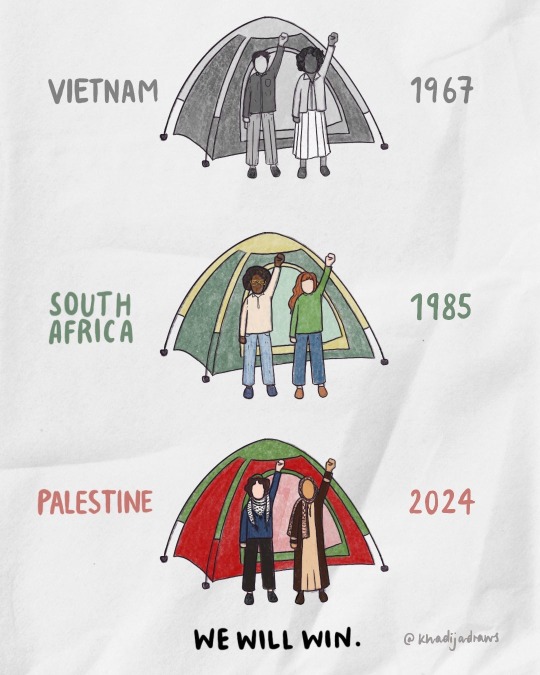
#art by: @khadijadraws#student protests#ucla#colombia university#free palestine#free gaza#freedom for all#save palestine#palestine#gaza strip#gaza#illustration#art work#art#vietnam#south africa#apartheid#war#politics#current events#protest#activism
731 notes
·
View notes
Text
Mario Savio giving a speech at Berkeley in 1964 during an occupation of the university.
I mistakenly labeled this as an occupation and speech against the Vietnam war. It was in fact an occupation by the Free Speech Movement, who objected to attacks on free speech and academic freedom during the cold war, when "radical" student groups were banned and faculty had to swear an anti-Communist loyalty oath or be fired. Students objected to universities being used as a source of knowledge and innovation for the military industrial complex but not being allowed to speak their minds that, which does have a lot of parallels with the current occupations.
There's a time when the operation of the machine becomes so odious, makes you so sick at heart that you can't take part!
You can't even passively take part!
And you've got to put your bodies upon the gears and upon the wheels, upon the levers, upon all the apparatus -- and you've got to make it stop!
And you've got to indicate to the people who run it, to the people who own it -- that unless you're free the machine will be prevented from working at all!!
#1964#mario savio#speech#berkeley#students#student protest#anti-war#free palestine#palestine#university#occupation#Berkeley Free Speech Movement
2K notes
·
View notes
Text
On May 4, 1970, during an anti-war protest opposing the war in Vietnam, sprung from the expansion into Cambodia, four students were killed, and nine were harmed by the Ohio National Guard at Kent State University campus. The students were unarmed. Not one of the shooters went to jail. A national moment that sparked even more anti-war protests and general condemnation for the american state.
Anti-war protests and support have historically been villanised. Under the Vietnam War, opposers were called commies. Under the 'war against terror', opposers were called terrorist sympathisers. When the US went into Iraq, opposers were called traitors. All were known as pushing anti-America sentiment—being unpatriotic—just as we hear being slung around today: opposers are terrorist-supporters, antisemitic and nazis. Creating rhetoric demonising demonstrators is favourable for the state's image and affairs, "they are the mad ones, so PLEASE stop criticising our war, our invasion, and our genocide". Patterned hindsight is why we must not forget that this is a historical tactic, which will only work if we forget. Hold them accountable for this genocide; in the future, they will try to soften their current actions out of embarrassment. It won't work.
The around 300 Kent State University students' demands lay as an echo over those we hear yelled from campuses all over the US this week. Student protests and organising have always been important measures in combating government actions and to all who are attending these protests: the world is seeing you; your demands are echoing through nation borders. I am proud of my fellow students and have, myself, been inspired to look into actions I can partake in at my own university. Thank you. Be safe. Free Palestine.
#kent state university#kent state#police brutality#campus protests#university protests#vietnam war#free palestine#palestine#politics#usa#fuck america#gaza strip
405 notes
·
View notes
Text
Columbia University students took over Hamilton Hall after the University’s refusal to divest from the State of Israel and complicity in the Genocide. Students have renamed Hamilton Hall to “Hind’s Hall” honouring 6 year old Hind Rajab, who was killed by the Israeli Defence Forces (IOF) after being the sole survivor of Israeli tank fire on the vehicle her family, of 6 other relatives, had fled in. Satellite imagery showed 3 tanks present in the area, countering the State of Israel’s claim that there was no military presence in the area at the time— the Washington Post later confirmed the satellite imagery and subsequent presence of Israeli tanks, disproving Israel’s claims. More on Hind Rajab here.


This occupation of Hind’s Hall (FKA Hamilton Hall) is reminiscent of Columbia’s history of student organisation, demonstrating and protesting— from rejecting the Vietnam War, to protesting War on Iraq. From AP: “When you’re going to Columbia, you know you’re going to an institution which has an honored place in the history of American protest,” said Mark Naison, professor of history and African & African American Studies at Fordham University and himself a participant in the 1968 demonstrations. “Whenever there is a movement, you know Columbia is going to be right there.”
Columbia University, and every student everywhere currently participating in encampment protests, you are apart of the future. Thank you for standing so strongly against injustice and inhumanity. Anti-Zionist Jews around the world stand with you.
#columbia university#free palestine#stand with palestine#protests#students#student power#education is power#hinds hall#nyc#updates#happening now#news
602 notes
·
View notes
Text
BG3 Characters Safest Driver Headcanons
I've been thinking about that poll from months ago way too much, so I've pulled this from my drafts.
In this essay, I will explain why Boo is the best driver.
Astarion: Terrible. Absolutely terrible driver. He is doing his makeup with the visor down, looking at the mirror more than the road. Suspend your disbelief, he's driving in this universe. He can use mirrors. ♥ You have to grab the steering wheel, regularly. Without warning, the man twists around to find his purse in the back seat because he wants a different eyeliner than what he grabbed. You are on aux duty. He hates everything you've picked.
2/10, he lawyered his way into that license
Gale: You would think he would be safe, but then you remember that Gale didn't pay attention in boring classes. And how hard could driving really be?? The man knows how to drive perfectly textbook. He also thinks he knows how to do it better than everyone else. He does not adapt well to poor drivers. The roads are full of poor drivers. He is yeling "Zipper!" at the merging traffic. You spend five minutes in the parking lot so he can find just the right song for the trip.
6/10, you will probably not die
Halsin: The man drives slow, I'm sorry. He's fuel efficient as you can get with the windows down. He pulls over and stops traffic for ducks crossing the road, no matter what the current road conditions are. He stops to show you the new tree the neighbor got. He is a Yellowstone Park tourist. He wants to show you the world, one traffic-stopping mid-road parking job at a time. There is no music, we are listening to nature today.
4/10, you will be rear-ended with him and not the way most people want
Jaheira: I stand by what I said last time: Jaheira reminds me of so many older women I know. She drives like she wants someone to start shit with her. She's so conditioned by having 5 kids fighting in the backseat at all times that every time she's behind the wheel she's having Vietnam-level flashbacks. Her blood is pumping in her ears. There is no road, there is only the red of her vision. She won't start the road rage incident directly, but by god, she will end it. (You tried to ask about music, but the look she gave you when asked killed the question.)
5/10, you make it to your destination intact. But at what cost? Your pants are a different color at the end of the trip than they were at the beginning.
Karlach: Karlach is talking with her hands while she drives. She's fiddling with the radio constantly. You've blown four red lights. Three of them were the same red light because she took a wrong turn. She will not use GPS, she's got the vibe of where she's going. She was trying to show you something on her phone at the same time. It cannot wait. It was so good you have to see it right now. The tunes are so loud she hasn't heard the sirens behind her.
4/10, the tunes almost make up for it
Lae'zel: You are helping her check her mirror distance before you get in the car. You are buckled in before the car even starts. You are not allowed to touch the light in the car if it is dark out. She was taught that it's illegal to have on at night and she takes that shit seriously. You are on blindspot-watching duty at all times. You're not allowed to have music on the in car, it is a distraction.
7/10, we are efficient, but we are miserable
Minsc: Minsc cannot drive. Minsc was meant to drive today, but Minsc got into the wrong seat. We are all relieved.
Jaheira trained him wrong on purpose and will kill you if you correct him.
0/10, don't even try. He will survive the accident, you will not.
Minthara: Minthara, light of my life. She is gremlin cackling and riding bumpers the whole time. People are pulling off constantly to get away from her. You are white-knuckling in the passenger seat and are too afraid to let go of the bitch-bar. You pray her airbags are up to date because your life has not stopped flashing before your eyes since you got onto the road. We are exclusively listening to The Flight of the Valkyries.
7/10, it is shockingly efficient when no one else is on the road anymore
Shadowheart: I have been in many a 'Shadowhearts' car. The car is more of a problem than she is. She drives the type of car that makes people go, "You live like this?" She drives a manual. She was not trained to drive a manual. Almost every single dash light is on, the ones that aren't had their bulbs die out years ago. We don't know how old that trash is, but it lives here now. She has one of those cassette players that has to hook into your phone to come out the speakers. Good luck finding the right adaptor in the mess.
4/10, girl get your shit together
Wyll: Wyll is the best driver, hands down...when he is alone. Like all things in his life, his greatest flaw is being too polite. He turns his whole fucking head to look at you when you talk because that is the polite thing to do. The road is secondary to how important your conversation and companionship are to him. And you can't not talk him! He's asking you genuine questions about your day because he's interested. You get to listen to whatever you want and he's totally down for it even if it's not normally his thing. He'll find something he likes about it.
Alone: 100/10, he somehow makes everyone better drivers by just being on the road
With you: 5/10, Wyll, please, look at the road. ;_;
Boo: My eyes are closed. It's better this way. We made it there in record time. I don't know how it happened. I don't need to know how it happened.
?/10, it's best if you don't think about it
#bg3#bg3 shitpost#shitpost headcanons#astarion#gale#bg3 gale#karlach#lae'zel#shadowheart#bg3 shadowheart#wyll#bg3 wyll#halsin#minthara#minsc#minsc and boo#boo#bg3 boo#jaheira
462 notes
·
View notes
Text
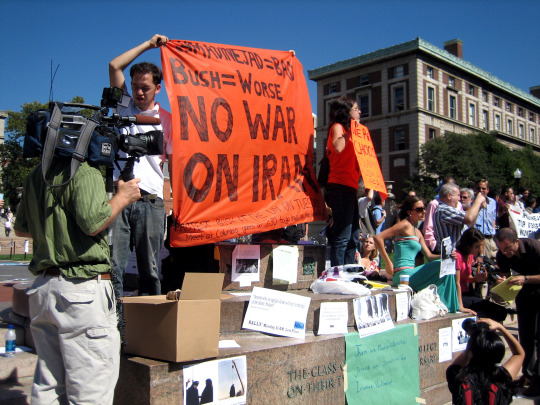
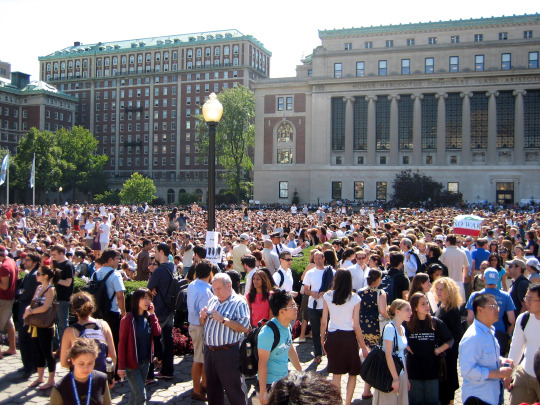
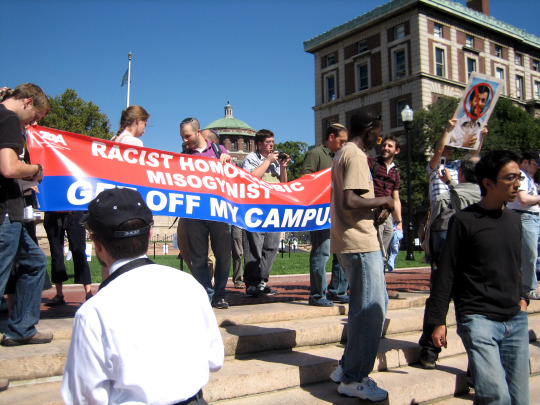
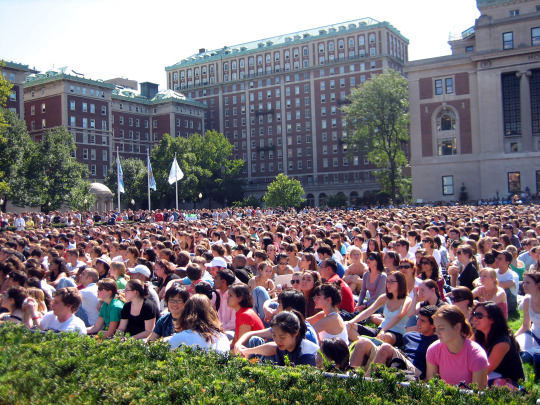


TBT to the late 00s when I was an undergrad at Columbia. It was a time when political activism and student protests saw a renaissance on campus; every year, for all 4 years I attended, there were protests—a resurgence of the spirit of '68. (I remember a meme going around comparing Ivy League schools with "How many students does it take to change a lightbulb at <insert Ivy here>?" The one for Columbia went something like "61. 1 to change the lightbulb, 30 to protest it, and 30 to counter-protest." I couldn't be more pleased, especially since the stereotypes for other Ivies were far less flattering.)
In 2007, then-President of the university Lee C. Bollinger, who was also a Free Speech scholar, invited then-President of Iran Mahmoud Ahmadinejad to speak on campus. There were protests against Ahmadinejad's arrival, and there were counter-protests, the latter calling out George W. Bush and US imperialism and upholding an anti-war message. Here are some photos I took the day of the event:
1 - Counter-protesters
3 - Protesters
4 - Students watching the event
5 - Flyers from protesters and counter-protesters
6 - Media outside the gates on Broadway
That same semester, there was a student hunger strike, calling for a reform of the Core Curriculum and expansion of the Ethnic Studies program and protesting the university's gentrification of Harlem. (I didn't take photos; this time I personally knew the protesters.) Students camped out in tents on the Lawn. And you know what? They weren't evicted. They weren't suspended. The cops weren't called. In fact, the university administration negotiated with them and agreed to meet some of their demands—the strikers won a new Major Cultures seminar requirement as part of the Core.
In 2008, on a panel commemorating the 40th anniversary of the 1968 uprising, Bollinger said, “You simply do not bring police onto a campus. All the assurances in the world cannot be kept” that police presence on campus will not result in violence.
Etc.
To the current student protestors, you are continuing Columbia tradition, and I am proud of CU students for sparking a nationwide movement. (The occupation of Hamilton Hall also harkens back to '68, when students seized control of the building to protest the Vietnam War and the proposal of a gymnasium in Morningside Park with separate entrances for students vs. the community. The spirit lives on indeed.)
To the current administration under Minouche Shafik... Sending in an armed and militarized NYPD as a response to kids peacefully protesting? How does that keep anyone safe? I can't imagine Bollinger would've been OK with how you're handling the situation. We alumni are watching.
// (c) Jenny Lam 2007
#free palestine#ceasefire now#palestine#gaza#ceasefire#from the river to the sea palestine will be free#palestine will be free#save palestine#free gaza#throwback#00s#2000s#columbia university#protest#student protests#nyc#history#activism#protests#columbia
198 notes
·
View notes
Text
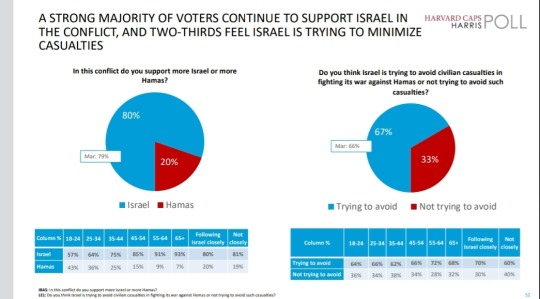
So one thing I do frequently is look through public opinion, and I think that's the best way to recognize we might be in a bit of an echo chamber. Because if you're younger and/or in left-wing space and your entire friend group and social media feeds are full of people who are pro-Palestine, it may be easy to think we are the overwhelming majority and the government simply is giving us the middle finger.
They are still giving us the middle finger, but we are unfortunately the large minority.
And, yes, I absolutely think the framing this question as a pro-Israel/Pro-Hamas dichotomy is influencing this answer, I doubt it wouldn't change that much mostly because a steady diet of Palestine=Hamas means most people subconsciously make that connection.
But I also think us being the minority doesn't make us any more correct. There have been many times
There is a striking similarity to what's today to the Vietnam protests on 1967/68. The style of President is similar (older white Democrats with quesionable pasts who succeeded more popular, younger President: LBJ and Biden), very similar public backlash, and student demonstrations that included encampments and a takeover of a building at Colombia University with vicious police repressions and disdain from University administration.
Those Vietnam demonstrations are venerated today, even held up as an example of "good" student protests against the "bad" protests today, even though in their time they were regarded almost exactly the same.
Another interesting point is the public opinion polling:
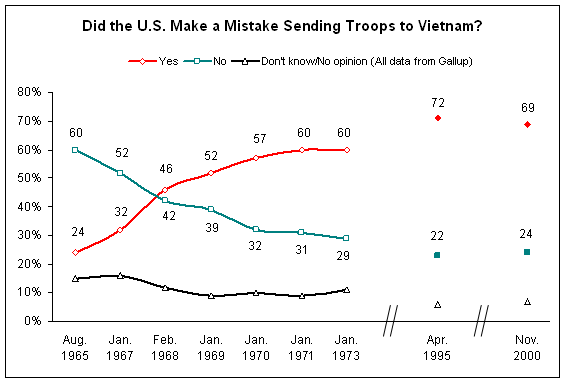
We're currently in the Jan 1967 polling point, it is possible, and judging by history, we will eventually will be vindicated as long as we keep going.
Keep advocating. Keep fighting. We can and will win this.
103 notes
·
View notes
Text
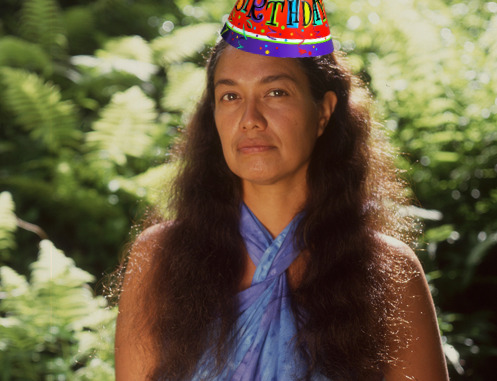
Happy birthday, Haunani-Kay Trask! (October 3, 1949)
A leading figure in the movement for Hawaiian independence, Haunani-Kay Trask was born in San Francisco before her family moved to O'ahu. She pursued an academic career, earning her PhD in political science in 1981. A Native Hawaiian, Trask founded the Kamakakūokalani Center for Hawaiian Studies at the University of Hawaiʻi at Mānoa, and heavily promoted and pioneered Hawaiian Studies as a discipline. Politically, Trask identified with left-wing currents, protesting against the Vietnam War and supporting the Black Panther Party. She utilized feminist theory, although she criticized mainstream American feminism as overly focused on white womanhood, and opposed the US military's presence in Hawaii while also opposing tourism to the islands. She was also opposed to efforts to group Native Hawaiians together legally with Native American tribes, and any efforts to further erode Hawaiian sovereignty. Her book From a Native Daughter: Colonialism and Sovereignty in Hawaiʻi is considered to be a seminal work of anti-colonial literature. Trask continued her advocacy and work until her death in 2021.
"Our story remains unwritten. It rests within the culture, which is inseparable from the land. To know this is to know our history. To write this is to write of the land and the people who are born from her."
288 notes
·
View notes
Text
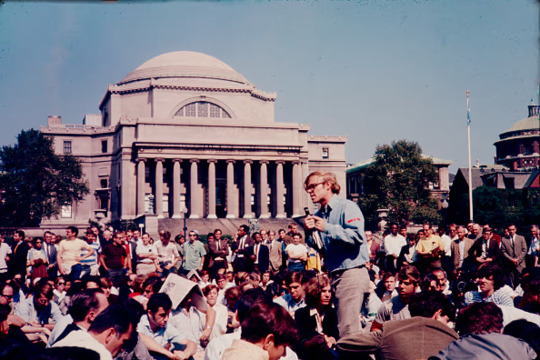
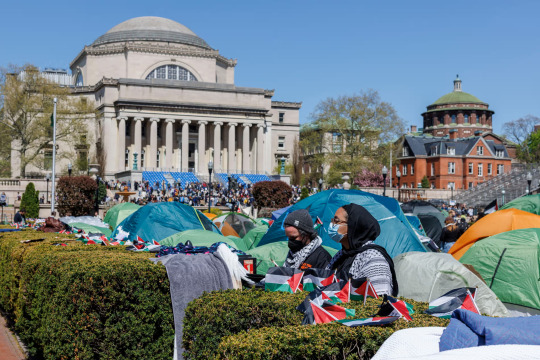
In 1968, Stein was one of 700 students arrested at Columbia during protests targeting both the university’s ties to the US military apparatus at the height of the Vietnam war, and the college’s plan to build a segregated gym, at the height of the civil rights movement. “This was really a crisis moment,” Stein, 78, recalls. “Students were taking a moral stand. We were ready to risk our careers, and our lives and our futures, and take a leap into the unknown and say, ‘No. We are not going to budge.’”
[...] But what hope – or cautions – do these older protest movements, and protesters, offer in the present?
[...]Observing the new protests from the outside, Stein found a great deal to admire. “I think the students have been incredibly organized,” she says. “And, let me say, completely peaceful.”
[...] The Pakistani British political activist and intellectual Tariq Ali, 80, is similarly buoyed by the images of the protests he sees on TV and social media. “I feel very joyous,” he says. “It does bring back memories.”
[...] “The most important thing,” he says, “is how important this is for the Palestinians, and how they must be feeling in Gaza and the West Bank,” he says. “That’s what we used to think when we were marching in the 60s. ‘Does it have any effect at all? Do the Vietnamese watching us know what we’re doing?’ And they did! Later on we found out that many images of demonstrations … were shown to the Vietnamese people, and to the Vietnamese army.”
Thanks to social media and 24-hour news coverage, US students haven’t had to wait to see thank-you notes from Palestinians in Gaza.
Stein sees a similar comparison, in terms of how Vietnam and Palestine serve to exemplify, and crystallize, the more egregious excesses of US (and US-backed) military campaigning. “In my day, the moral issue of our time was Vietnam,” she recalls. “When I look at the students today, I think they’ve identified the ongoing genocide in Gaza, and the US’s role in arming and providing high-speed, high-scale weaponry, 1,000-pound bombs, for Israel, and they’re saying: ‘Business as usual can’t go on.’”
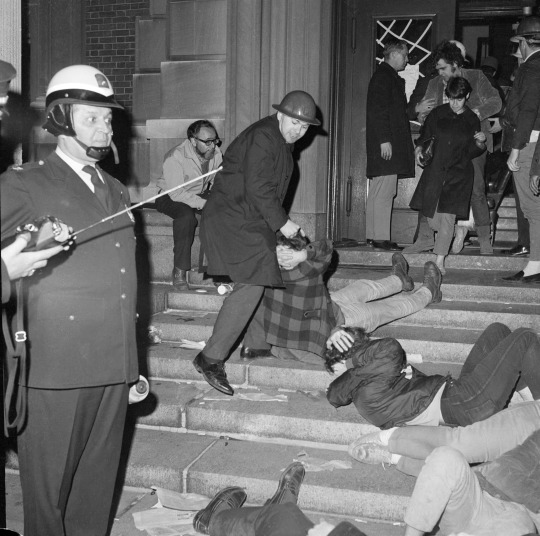
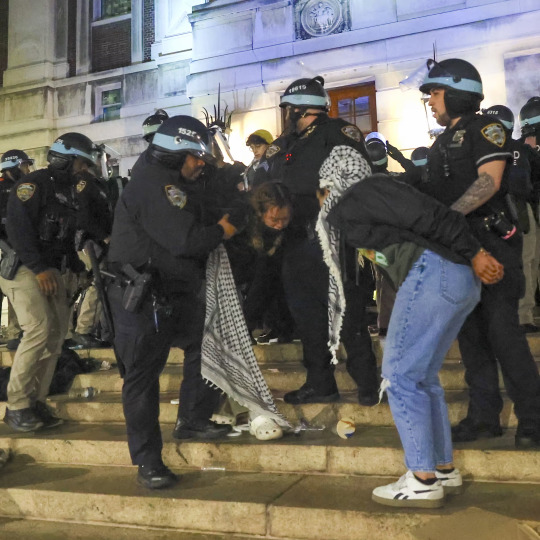
For other veterans of the American left, the direct comparison between the Vietnam war and the military incursion in Gaza feels a bit incomplete. The American writer John B Judis – a Berkeley grad, frontliner at Vietnam war protests, and self-identifying democratic socialist – thinks the current situation is more complicated. “I welcome protests against America’s unconditional support [for Israel],” Judis says. “For me, it’s a question of whether the student protests are an effective way of doing that.”
[...] For Judis, the current movements evoke some of the missteps of earlier protests. “They recall, to some extent, the errors that the anti-imperialist wing of the New Left made in the 60s,” he says. “They’re not focused on ending America’s unconditional aid to Israel, but on these broader goals: free Palestine. Or they want to see a secular democracy of Palestine, which I think is really unfeasible. It’s not going to happen. The Israelis are not going to allow that to happen.”
[...] Judis argues that such broadly anti-imperial aims are not only unrealistic, but also indulge a certain tendency toward “romanticizing foreign governments” that has long dogged American leftism. He cites previous generations’ glorification of Fidel Castro, Mao Zedong, and Ho Chi Minh as examples.
[...] “The idea that this is too controversial, or will produce such a conflagration of ideas, is exactly the opposite of what the university is for,” Stein says. “And students who want to discuss it have been silenced. I think that has led to frustration, and anger, among the students. Protest does have a history on campus. But in this case, the protests were necessary to even get a conversation started about what’s happening in Gaza.”

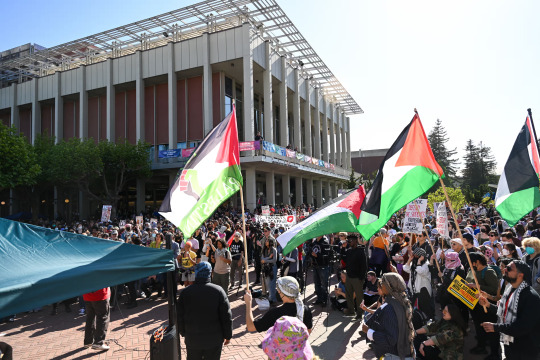
[...] A man of Quaker and Jewish upbringing, Isserman condemns Israel’s inordinate response to Hamas’s aggression, while maintaining that the nation has a right to exist, and to defend itself “within limits that it too often violates”. And he has a hard time watching socialists (new and old) throw their lot in with fundamentalist groups. “These people are not our friends,” he says of Hamas. “You’re talking about a rightwing fundamentalist sect; a murderous sect. [The protesters] are making a very old error. Just in a new time.”
The New York University historian Michael Koncewicz notes that the anti-Vietnam war movement drew a broader coalition: not just progressive college students and American communists but liberals of all stripes. “There were people who viewed the Vietnam war as a tragic mistake that we needed to end. And then there were those who viewed it as a criminal act perpetrated by the American empire,” he says. “Those two sides were both on the streets.” That said, in his research and reporting, Koncewicz has found broad levels of support for the current movement among older radicals. “This is something that not a lot of young New Leftists had in the 60s and 70s: actual support from elders.”
[...] Historically, the US role in foreign conflicts hasn’t really moved the needle in domestic electoral politics. “We’re in uncharted territory here,” saysKoncewicz, “in terms of trying to figure out whether a foreign policy crisis will actually impact an American election. Because very few do. Most times, these things don’t matter.”
But the recent action across campuses speaks to a more intimate front emerging in the conflict. Another key distinction between the wars in Gaza and Vietnam is that the latter also took the form of a domestic crisis, with the mandatory military draft drawing American families (and voters) into this far-off conflict much more directly. The campus protests could have a similar effect. Images of militarized police forces sweeping through campus quads, rounding up students, professors and other assembled sympathizers, may win hearts and minds more than the images of a war being waged halfway across the world. “We saw that in the 60s and 70s as well,” says Tariq Ali of the police presence on campuses. “This is nothing new. What is interesting is they’re not being called by the governors of the states concerned [as in the 60s], but by the heads of the universities.”
The disgust at the authoritarian response to these protests seems to run across the various splinters fracturing the contemporary socialist left. “I have some criticisms with the encampments,” Isserman says. “But when you send in the cops, then my sympathy is with the students. That’s a separate issue from whether they could be more effective if they moderated their stance.”
Eleanor Stein hopes that, if history is any precedent, the reaction to these protests may be the thing that shifts public opinion. Like the draft, images of students being rounded up in paddy wagons wheeled on to college campuses may have a way of bringing the war home, and moving the needle of public opinion.
“In 1968, Columbia was quite divided about the protests,” she says. “But once we were all arrested, and the police were occupying our campus, the tide of opinion shifted dramatically in our favour. And that’s what you see happening now. This is how people learn … It represents a tremendous force for change. And without it, I shudder to think of where we would be.”
(x)
76 notes
·
View notes
Text
"Ten years ago this August, a white police officer killed 18-year-old Michael Brown in Ferguson, Missouri. What happened on Canfield Drive that day sparked a nationwide movement to save Black lives, end police brutality, and make safety a reality for all people. As a registered nurse, pastor, and local activist, I spent over 400 days protesting alongside thousands of my fellow community members.
I will never forget the brutality we faced in response to our calls for humanity. Police used tear gas, pepper spray, rubber bullets, noise munitions, batons, shields, fists, and boots against us. The Missouri National Guard called us “enemy forces.” Our government labeled us “Black identity extremists.” Many politicians condemned us. Those of us on the front lines were traumatized, but we knew that time would prove we were on the right side of history — and it did. Time will prove the same for the students currently protesting across the country.
....
None of what protesters in Ferguson and at Columbia University have experienced is new — it’s happened hundreds of times throughout our history. It happened in Boston in 1770, when protesters supported independence from British rule. It happened in Pennsylvania in 1897, when mine workers demanded labor rights. It happened in Virginia in 1917, when protesters demanded equal rights for women. It happened in Selma in 1965, when protesters demanded civil rights for Black people. It happened in New York, Chicago, St. Louis, and elsewhere in 1968, when protesters demanded an end to the Vietnam War. And it happened in Washington, DC, and in communities all across our country in 2020, when protesters demanded an end to police brutality.
Behind every attempt to silence a protester is an idea that those in power don’t want people to hear, yet protest movements have been remarkably successful throughout our history. The women’s suffrage movement led to the ratification of the 19th Amendment despite opposition from those in power. The same is true of the Civil Rights movement, which culminated in the Civil Rights Act of 1964 and Voting Rights Act of 1965, and the youth-led nationwide protests that led to the end of the Vietnam War, and South African apartheid.
...During the Ferguson protests, a group of Palestinians visited us and taught us how to protect ourselves against tear gas. That moment opened my eyes to the connection between state-sanctioned violence at home and abroad.
..It’s time our government responded to popular social movements with an ear, instead of a boot.
#student protests#cori bush#police state#police brutality#police violence#solidarity#gaza solidarity encampment#palestine#free palestine#gaza#genocide#isreal#colonization#apartheid#american imperialism#us politics#settler police#settler colonialism#settler violence
87 notes
·
View notes
Text
About Marvel's timeline
Here's something else important to keep in mind as I made my way through these comics: the way Marvel handles its timeline.
Marvel's comics have always been set in a fictionalized version of the present day real world that just so happens to also have superheroes and aliens and magic and whatnot. They've never been shy about referencing real world events or pop culture to ground the comics in our reality. The first ever Spider-Man story mentioned that he should go on The Ed Sullivan Show. Iron Man's classic origin story involves the Vietnam War. In the far, far future, I'm gonna have to cover the infamous 9/11 issue of Spider-Man where Marvel's heroes AND villains mourn at Ground Zero.
Marvel's main universe has also never had a true full-on reboot. They'll do their big dumb crossover events that Change Everything Forever™, sure. (God, I am not looking forward to having to worry about crossover events.) But, like... the stuff that came before still happened, for the most part.
So, combine these two facts, and you've got 60+ years of comics referencing then-current events that are basically all still in continuity... but the characters haven't aged 60 years. Things operate on a floating timeline - or a "sliding timescale," as Marvel seems to prefer. But unlike, say, The Simpsons, where the characters never age, some time HAS passed for Marvel's cast! Spider-Man isn't 17 forever, he's grown up over the course of the series. There's of course some timey-wimey nonsense that was invented decades later to explain this bizarre chronology, but basically, the characters get a year older about once every four real world years.
So, long story short: those 60+ years of comics get compressed to about, say, 15 years of in-universe history.
What of all the topical references, then? Just... don't think about it too hard. Marvel continuity supernerds will tell you those aren't supposed to be literal, and most get retconned out with enough time. (A few years back they invented a fictional all-purpose southeast Asian war that can perpetually be pulled forward with the sliding timescale, to replace outdated references to the Vietnam War and the Korean War.) If you go on the Marvel wiki and try to edit references to real world history into a character's biography they'll bust your fuckin' kneecaps.
On the other hand: it's funnier if you take them literally. So as we go through these early Spider-Man comics where characters reference things like twist music, just remember that - at the time of writing this in 2023 - the events of those comics are now considered to be set in about 2008 or 2009.
156 notes
·
View notes
Text



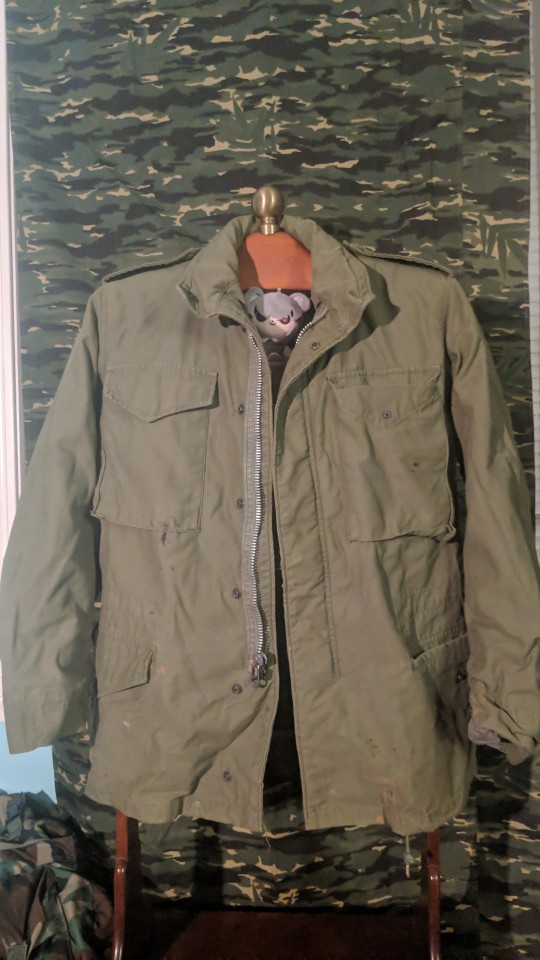


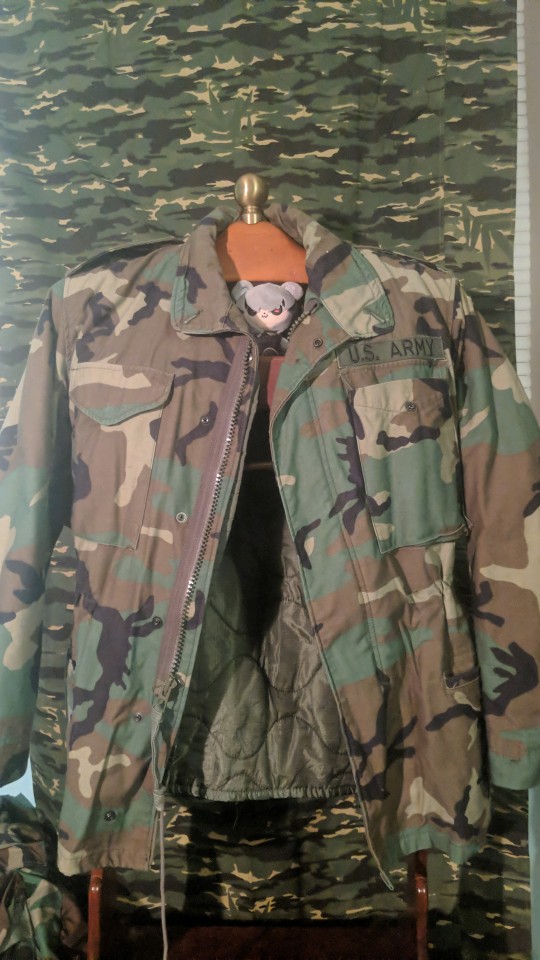


A (non)comprehensive evolution of the US Army field jacket, from 1945-2007. These are all original specimens, with or without optional items, and thus is incomplete before 1945, because using reproductions is never 1:1 and is cheating. (Unless its SMWholesale.)
1943-1953: M1943 Field Jacket, Civil Defense.
Pictured here is a Civil Defense variant, which outlived its military counterpart in service life. (This one is here because I haven't gotten around to focusing my autism on collecting them yet.)
1950-1953: M1950 Field Jacket.
An update to the M1943 with interior buttons for liners, a swing-out arm gusset and other improvements, mostly for making it more presentable for dress uniform. The M1950 makes its debut in Korea, is found wanting for actual combat, and within a year is superseded.
1951-1970s: Early M1951 Field Jacket.
A more field use oriented jacket, the M1951 introduces a zipper and snaps to the field jacket, while still retaining button in liners. The M51 survives Korea and enters Vietnam. Later production M51s can be discerned by white labels and green buttons, whereas early M51s have an ink stamp and brown, WW2 production buttons.
1965-1990's Early/Vietnam Era and Post-War OD M1965 Field Jackets.
The M65 iterates further on the field jacket, while adding additional features and simplifying manufacturing. most notably a stowable built-in wind hood and velcro wrist cuffs with stowed flaps to extend over gloves. The early Vietnam era M65s are distinguished by having 2 white cotton inkstamped labels, one on the neck, and one behind the right lower pocket, alongside aluminium zippers like the M51. Post-1973 M65s have brass zippers and either still retain the 2 labels, or have a single, larger label at the neck. (The Vietnam Era one here was acquired in Vietnam and was used in the war, and was repaired numerous times by many people until it found its way to me.)
1981-2008: Early and Late Woodland pattern M1965 Field Jackets.
The only significant difference on the early woodland M65 from its predecessors is its change to camouflage, entering service with the BDU in 1981, but served alongside the OD M65 all throughout the 80s and 90's, never fully replacing it. Early and Late Woodland M65s can be differentiated by a change from brass Talon zippers to green coated YKK zippers, and from white letterpressed or inkstamped labels to green letterpresses labels. (There is also the change of using woodland fabric to OD fabric in the hip pockets but that varies by manufacturer.)
1989-2008: 3 Color Desert M1965 Field Jacket.
A contract of 3CD M65s were made in 1989 for potential actions in desert areas around the globe, made to the same cut as the Late Woodland M65s with tan coated YKK zippers. Few made it in time to be issued in Desert Storm, among with the DCU, but saw more extensive issue in the rest of the 90s, and in Desert Shield, Iraq and Afghanistan. Another batch was made in Contract Year 2003, and changed the cut to the final iteration of the M65, without shoulder or nametape velcro. (I am too lazy to photograph this one right now.)
2004-2008: Universal Camouflage Pattern M65.
The last breath of the M65 in service to the US. By the time it was issued it was no longer competitive with other cold weather clothing systems, and many commands did not authorize them for dress uniform. Other parts of the M65 system were made in UCP, but befell the same fate. Velcro for shoulder patches and nametapes were added, and liners in the same color were even made for them. Only a single contact year was ever ordered, and by 2008 the M65 was phased out of service. Maybe, someone high up might get nostalgic, and order new ones to be made in the current camouflage for dress uniform, but if ever that happens, the story ends here.
56 notes
·
View notes
Text
May 2024 Important Dates

AKA my notes from The Astrology Podcast's May Forecast.
April recap: on the 8th we had the solar eclipse in Aries that covered much of the United States, during a Mercury retrograde and right before a Mars-Saturn conjunction--all also in Aries! In international news this connects to Iran's retaliation for Israel's strike on its Syrian embassy. A tragic eclipse story is of astrologer Danielle Ayoka, whose death after a mental breakdown was sensationalized by the LA times as part of modern-day Satanic Panic. Our hosts urge the wider astrological community to learn more about how to support others who may be going through a mental health crisis and extend sympathy to the affected families. The inflammatory reporting also connects to a larger story of backlash against astrology as Saturn approaches a conjunction with Neptune in Pisces and the latter leaves the sign.
On April 10th we had an exact Mars-Saturn conjunction in Pisces, which a previous forecast predicted would correspond with issues of contaminated water, maritime warfare, and flooding. On the day of the conjunction, the EPA issued the first national limit for forever chemicals in the water. Saturn signifies both the restrictions and the longevity of the chemicals. There was also torrential flooding in Dubai, Russia, and Kazakhstan.
Jupiter conjoined Uranus in Taurus on April 20th; these planets only align every 14 years. Jupiter-Uranus indicates uprisings and revolutions: the last one corresponded with the Arab Spring, and there was also one in 1968-70 during Vietnam War protests, as well as the French and American revolutions. The student protests at Columbia (and later other universities) calling for divestment and ceasefire in Gaza are a direct connection here (the current encampment was directly inspired by student protestors doing the same thing in 1968 to protest the Vietnam War). These protests began on April 17th and saw a boom in media coverage when the conjunction went exact. The 1969 conjunction was in Libra; in Venus-ruled signs this alignment signals uprisings of "we don't want to be at war!" If these protests did start right at dawn on the 17th, this would have the Jupiter-Uranus conjunction (already exact by degree, but not minute) rising, fitting for an action that has sparked events across the nation.
Another Jupiter-Uranus story includes Congress passing a bill wrapping together military funding for Ukraine, Israel, and Taiwan with a probable TikTok ban. A historical connection here is the passing of the Lend-Lease bill in 1941, a precursor to the US entering WW2. With the US Uranus return coming up (which corresponds to the Civil War and WW2), Chris is nervous. Other conjunction stories include the restoration of net neutrality on April 25th (Taurus ruling basic necessities and resources), the Department of Transportation mandating airlines to give refunds (the Wright Brothers flew under a Jupiter-Uranus conjunction), the FTC put a ban on employer non-compete agreements, and a VW factory in Tennessee successfully unionized as part of UAW--one of the first unionized auto factories in the South! These regulation stories also fit with Saturn bringing rules and regulations.
We're entering the month of May right as Mars enters his domicile Aries, freeing us of the Saturn conjunction, Mercury stationing direct, and Venus in her home sign of Taurus.
May 2nd - Pluto stations Retrograde
This occurs at 2 degrees of Aquarius and will see Pluto backtrack into Capricorn for the final time this summer. Retrograde stations intensify the significations of a particular planet in that sign, and this particular one occurs with a square from Venus in Taurus and copresence with the Moon. Pluto in Aquarius developments include developments in AI & technology, and with Venus signifying the arts we can expect AI image/video developments. On a personal level Venus-Pluto can indicate deep, transformative relationships as well as control, manipulation, and power dynamics. Venus in Taurus also activates the Jupiter-Uranus conjunction, especially in the realm of our relationship to the natural world & differentiating what is real from what is fake. On a more positive note, this is a good time to indulge in creative projects, and with a retrograde especially, returning your idea to its original state. Venus-Pluto also relates to issues of women's rights and bodily autonomy (ex. Roe v. Wade).
May 7th - New Moon in Taurus

At 18 degrees of Taurus, the New Moon forms a sextile to Saturn (17♓), and soon approaches the Jupiter-Uranus conjunction (orb 3) just a few degrees away. Jupiter-Uranus themes will become more pronounced collectively and in our personal lives, likely bringing new chapters in the stories discussed in the recap. Also in Taurus is Venus, who's slowing down after her zip through Aries and emphasizes relationships as she brings us back down to earth. Meanwhile, Mars in Aries doesn't make many aspects to other planets this month (even copresent Mercury is moving away from him), making him a bit of a renegade, but also not interfering with other planets. On the 25th Mars will reach the degree of the eclipse (18♈), so those affected by the eclipse, especially night charts, will definitely see extra focus in this part of their lives, while day charts can expect some challenges.
May 12th/13th - Sun conjoins Uranus (not pictured)
This Taurus season sees the Jupiter-Uranus conjunction continually activated. Rather than the usual relaxation, we'll hear the bells of rebellion tolling over and over. (Another date to watch is May 18th, when the Sun hits Jupiter.)
May 13th - Mercury enters Taurus
He exits his retrograde shadow before this ingress and at the same time Venus sextiles Saturn, clarifying conversations. We'll feel like we're finally done with some hassles. Mercury's ingress into Taurus also focuses the solid majority of our energy in this area, rather than splitting it with Aries. However, he squares Pluto immediately upon entering, so before smooth sailing we'll have to deal with intense focus, digging up the past, and uncovering secrets. This might deepen conversations as Mercury treats the same issues Venus brought up with her square to Pluto earlier this month, but now with more distance and calculation than the tender emotions, or it can amplify those issues with a microphone.
May 14th - Electional chart for the month (not pictured)

May is actually one of the best months for electional astrology all year, free of Mars retrograde and most outer planet tensions that will overshadow the later part of the year. This selection is for about 12:30PM local time. This should give Leo rising, and the Ascendant ruler the Sun is in Taurus within 3 degrees of a conjunction to Jupiter in the 10th house. Venus is also in Taurus, squaring a Leo Moon in the first house. This is a great chart for 10th house matters like career, reputation, and public image, with the Ascendant ruler fully bonified by Jupiter and supported by both benefics. With the first house connection Diana suggests this is also a good time to update your work wardrobe or possibly website in ways that may seem unexpected. It's a good time to do something unique or innovative with Uranus placed so prominently. It's not as good for ninth house matters like foreign travel, as Mars is there in a day chart.
May 18th - Venus conjunct Uranus, Sun conjunct Jupiter
Venus conjoins Uranus (23♉) at the same time that the Sun conjoins Jupiter (28♉), bringing us optimism and excitement. It's extremely buoyant and can be disruptive simply by virtue of so much happening at once. It's a Saturday, so a great time to have fun, but be prepared to sleep in late the next day. We can find new relationships that begin quickly but burn out fast too, and run into unexpected good luck.
May 19th/20th - Mars conjoins North Node (not pictured)
The next day the Moon enters Libra and opposes this configuration, activating it. Mars takes the place of the Sun in an eclipse, reactivating the stories that these Aries-Libra eclipses have been pinging in our lives. Mars's anger may be in response to people crossing our social boundaries represented by the Moon in Libra. With the Moon bringing in the South Node and Mars's severing associations, we may become aware of things we need to relinquish or cut off. Picking fights can lead to consequences you really don't want.
May 20th - Sun enters Gemini
This ingress foreshadows the stellium of planets in Taurus shifting to Gemini.
May 23rd - Full Moon in Sagittarius, Venus conjunct Jupiter, Jupiter sextile Neptune, Venus enters Gemini
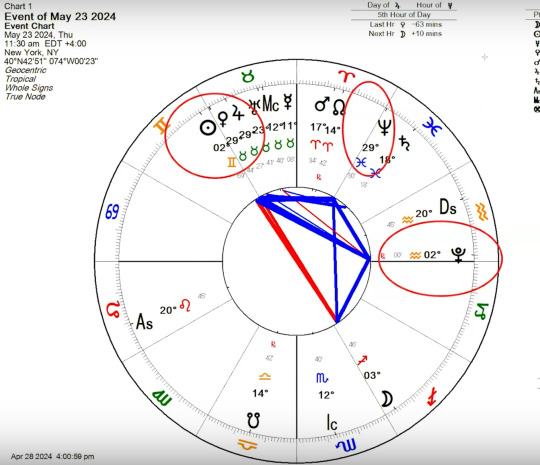
This Full Moon is opposite the Venus-Jupiter conjunction (29♉), both of whom sextile Neptune (29♓), and when the Moon exactly opposes the Sun it sextiles Pluto. This is a more positive and optimistic lunation than what we've been seeing so far: the best of the night sect with the best of the day sect. Agreements made during this time will have staying power, and it's a good sign for peace in world events. Neptune connotes idealism in these accords--sometimes you need ungrounded hopes and dreams to go on. Venus-Jupiter conjunctions can also bring too much of a good thing, so be careful not to overindulge. This is also a good time to enjoy material and sensual comforts. It's the perfect day for a picnic!
Venus joins the Sun in Gemini soon after.
May 25th - Jupiter enters Gemini
Jupiter spends about a year in a sign, and we'll be shifting from slow, grounded Taurus to mutable, airy Gemini. He'll be trining Pluto in Aquarius while here, accelerating technological advancements like AI and innovations in transportation. Diana uses the image of lots of busy bumblebees trying to collect lots of different information very rapidly. It might be overwhelming, and we could see heightened allergens. This also sets up the next month, where we'll have lots of activity in Gemini...all of which will square Saturn in Pisces! It'll be a lively air and water show with changes in short-term travel. In our personal lives, the combination of Venus & Jupiter will alleviate some of the issues we've been feeling in mutable signs, where places we've felt weighed down and restricted will receive some levity and buoyancy. Whichever house Gemini occupies in your chart will see some smooth sailing for awhile. Use this positive support in Taurus and Gemini to make hay while the sun shines!
May 31st - Mercury conjunct Uranus
Mercury is the last planet to ping Jupiter-Uranus conjunction; in general there is a lot of planetary activity in Taurus this month, really activating whichever house that falls in for individuals. Mercury brings a megaphone to the final blast of energy from Taurus. Surprising news, unexpected communications, and conversations with unlikely sources are in order. Uranus-Mercury can open up possibilities that you never could have predicted, and are good for thinking on your feet. Both planets are associated with the nervous system--it's a good day to be cautious with your caffeine consumption.
Whether you need to be active or just rest, take advantage of the stability and help this month!
#astrology#transits#forecast#may 2024#pluto retrograde#mars in aries#jupiter conjunct uranus#jupiter in taurus#jupiter in gemini#venus in taurus#venus conjunct jupiter#venus conjunct uranus#sun conjunct jupiter#mercury conjunct uranus#venus square pluto#mercury square pluto
27 notes
·
View notes
Text
‘We won’t stop’: How Columbia’s students etched a new Gaza protest legacy
Inside a movement that took over a university building and lost its encampment within 24 hours – yet refuses to die.
New York, United States — At about 10pm on Monday, April 29, I thought I would call it a night.
My student journalist colleagues and I had stayed late into the night on Columbia University’s campus the previous couple of days, reporting on a story that had grabbed the world’s attention: the pro-Palestine protests and encampment that had inspired similar campaigns in schools across the United States and globally.
As I slung my camera bag on my back and began to leave campus, walking by the camp, I got a tip from a passing protester: “I would stick around till about midnight,” they said. “Maybe go home first, though.”
Got it. I went home to charge backup camera batteries and grab spare memory cards before leaving for campus again.
Back at Columbia, it appeared that more than one of us had gotten the tip. Crowds of student journalists, all of us with matching paper badges and blue tape on our clothes, waited next to the encampment for whatever was to come. Our journalism faculty stood by our side, as they had been doing throughout.
Protesters grouped into “platoons”, and while we didn’t know what to expect, we kept eyes on different corners.
We split up to make sure different spots were covered; a few of us stuck by Pulitzer Hall, the home of Columbia Journalism School, where a small number of protesters had convened, while some others stood ready with cameras and recorders by the encampment.
That is when it all began. Campers began walking their tents off the lawn. One group began chanting. Another at the opposite end of the lawn sang protest hymns. I was with a small cohort of journalists who followed the tents to another small lawn, a clever decoy – whether intended or not – that meant many of us missed the moment, at the opposite end of campus, when protesters entered Hamilton Hall.
By the time we had run over, tens of student protesters had gathered to link arms outside the building, which their predecessors had taken over in 1968 to protest against the Vietnam War, and in 1985 to demand that Columbia divest from firms tied to apartheid South Africa.
Two of my colleagues were in the middle of the scrum, up against the doors watching two counter-protesters attempt to stop the occupation before being pushed out. Protesters rushed metal picnic tables, wooden chairs, trash cans, and planters to the doors where they were zip-tied together, effectively forming a barricade.
Two masked individuals appeared from a second-floor balcony to cheers and applause. They unfurled a hand-painted sign, “Hind’s Hall”, a reference to the six-year-old Palestinian girl who was killed with her family in their car in January as they tried to escape Israel’s military assault in Gaza.
That night, I fell asleep on the floor of a sixth-storey classroom in Pulitzer Hall to the echoes of song, one lone voice amplified through a megaphone, coming from Hamilton Hall: “This joy that I have, the world didn’t give it to me … the world can’t take it away.”
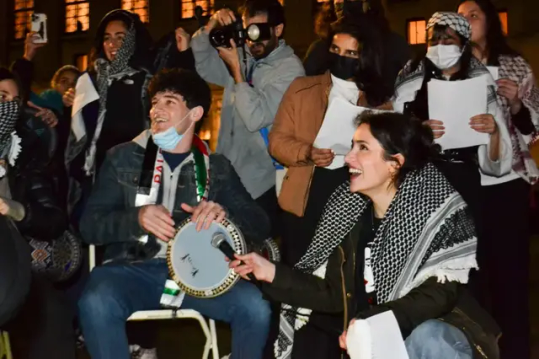
Student protesters playing music at the Columbia University encampment in New York City [Yasmeen Altaji/Al Jazeera]
The final offer
The morning before had felt very different. Columbia University’s South Lawn was packed, and the little protest village in the heart of the campus – dozens of tents and tarps comprising the “Gaza solidarity encampment” – was bustling with life, two weeks since its erection.
The protest is rooted in a decades-long movement for Palestinian rights in their homeland, and to hold Israel accountable for its illegal occupation of Palestinian territories. The current campaign against Israel’s war on Gaza – in which more than 34,000 people have been killed – also aims to pressure Columbia to divest from Israel-linked companies, just as the university did in the case of apartheid South Africa after similar protests four decades ago.
In my time covering the protest, the sounds at the encampment varied. Some days, you could hear the (Islamic) adhan, or the chants of (Jewish) Passover prayer. Or the sounds of the dumbek (drum) and sharp violins echoing microtonal hymns of Palestinian folk music and classical Andalusian muwashshah. Speakers amplified the melodies of iconic musicians like Abdel Halim Hafez and Fairuz.
Protesters shared donated hot meals – pizzas and samosas, bagels and eggs, sacks of mandarins and tubs of crackers, muffins and cookies spread on a tarp aptly called the “cornucopia”.
One camper had set up a makeshift nail parlour, painting red, white, black and green manicures matching the Palestinian flag. Cardboard “street signs” named the tight spaces between rows of tents “Walid Daqqa Road”, after the Palestinian novelist and activist who died of cancer in April, while in Israeli custody.
In the lawn’s centre, organisers routinely updated a whiteboard to reflect the day’s programmed activities: Dhuhr prayer and Shabbat dinner, with jazz in the mix, too.
In a corner of the lawn near the main campus walk, an “art guild” was buzzing with protesters painting signs, drawing patterns of the keffiyeh, decorating and personalising tent spaces.
But that Monday, campers received a final offer from the university administration under President Nemat “Minouche” Shafik: evacuate now, and evade suspension. Campers defied the order.
And by Monday night, the morning’s bustle had died down to a hum, then a whisper, before the eruption that culminated in the takeover of Hamilton Hall. At the encampment site, the zipper flap doors of empty tents billowed in the breeze. Blankets lay crumpled beside pillows still dented from a nap; a sole LED lantern left lit on the ground, a paintbrush crusted with dried red and green acrylic lay stuck on a paper plate.
It’s a community that student journalists like myself at the Columbia Journalism School had closely observed for days at a stretch, unlike the “outside media” who were only allowed on to campus in daily two-hour windows since the encampment went up. Joining us were undergraduate peers at student publications including WKCR and the Columbia Daily Spectator.
A community that, through the intensifying attention on its members, had been trying to emphasise that they weren’t the story. Signs planted across the lawn read: “All eyes on Gaza.”
But in the 24 hours that would follow, the world’s gaze on Columbia would only sharpen.
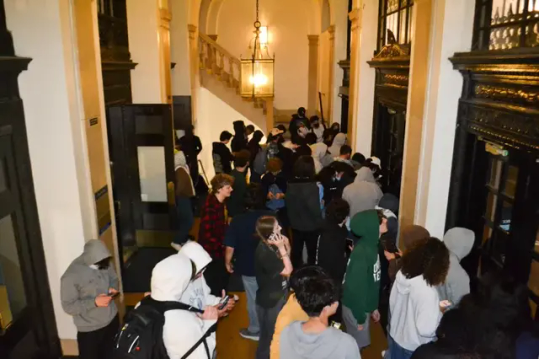
Students were trapped inside the entrance vestibule at John Jay Hall in Columbia University in New York on Tuesday, April 30, 2023 [Yasmeen Altaji/Al Jazeera]
The raid
Tuesday morning started eerily quiet. The camp was empty, save for a few protesters, and Hamilton Hall was sleepy, the only movement coming from a banner reading “INTIFADA” hanging off the side of the building.
Just a few days prior, far before the occupation of Hamilton Hall, the Columbia administration had sent a notice arguing that “to bring back the NYPD at this time would be counterproductive, further inflaming what is happening on campus, and drawing thousands to our doorstep who would threaten our community”.
The note was met with mistrust by protesters: After all, the university had already called the police to campus for the first time in more than 50 years in April to try to clear the encampment. More than 100 students had been arrested.
Instead, I heard organisers advise campers to pack their belongings in trash bags and write phone numbers on their arms in case of arrest.
By Tuesday night, their apprehension would turn into reality. The NYPD entered Columbia’s campus shortly after 9pm on Tuesday (01:00 GMT on Wednesday).
Students linked arms and sang together in anticipation before the harmonies of “We shall not be moved” merged with the march of hundreds of police officers making their way, in formation, to Hamilton Hall.
Calls through long-range acoustic devices (LRAD) to disperse or face arrest, echoed across the campus square, all the time weaving in and out of the floating tunes of the protest hymns, earworms that anyone who’d been on campus had likely come to memorise.
Protesters outside of Hamilton braced for arrest. But officers turned away from them upon arrival, and instead turned towards us – onlookers and press.
Officers instructed us to vacate the area. We walked backwards to get everything on video. “It’s easier if you face forward,” one officer said. “Turn around so you don’t fall,” another yelled repeatedly in a collective command. “Time to go inside,” another said. “Back to your dorms.”
While our backs were against the door of a building at the end of the courtyard where Hamilton was, the doors opened, and officers raised their batons, giving one final push until we were all inside. There was a moment of disorientation before we realised where we were: inside an undergraduate dormitory called John Jay Hall.
It’s where the student health centre, a dining hall, and a late-night campus eatery are. But we couldn’t see any of that. While police guarded the doors into the entry vestibule of the building in front of us, campus security guarded the rest of the building behind us, restricting access to dorm residents.
With about 30 or 40 of us squeezed into the small entry vestibule, ventilation was poor. We wouldn’t reach the bathroom. Red arrows pointed towards the emergency exit but the doors were blocked by officers. Phone batteries were dying. And most pressing, for the journalists among us: we couldn’t see Hamilton beyond the bodies of officers standing at John Jay’s glass doors.
For about three hours, students kicked at the front doors, slouched on the ground against the wall, and slept with their backpacks as pillows. One student sat cross-legged on the floor, sobbing softly while her friend comforted her.
Three hours passed in that hall before we were let out, officers directing us to dorms and buildings they did not know the names or locations of. “We know you want to get out of here. We’re doing you a favour,” one said.
As I left campus at about 1:30am, I walked past a crew hauling the tents off the South Lawn and into a garbage truck that crushed them on the spot.
[See embedded video in the article]
The remains
On Wednesday, the tension wasn’t palpable, only disappointment. The campus was quiet, but not calm. It was completely empty. No one, aside from residents and essential staff – which the journalism faculty ensured we were viewed as, as student journalists – were allowed past campus gates.
Where the encampment once stood, there were only marks of discoloured grass in the shape of rectangular tent bases.
But the movement seems anything but a ghost; on Wednesday, protesters hosted a “light show” beside the campus, projecting titles onto the public-facing side of Hamilton Hall that read “Hind’s Hall forever.”
Every year, on the eve of exams, students gather to let out what is known as a “primal scream” on campus. On Thursday, they took that tradition to Shafik’s house, shouting outside her door.
On Friday, protesters again lined the street outside of Columbia’s gate. And the words still rang through the neighbourhood: “Disclose, divest, we will not stop, we will not rest.”
#palestine#free palestine#save palestine#gaza#free gaza#save gaza#israel#israel palestine conflict#israeli apartheid#bds boycott#boycott israel#bds movement#war on gaza#gaza genocide#gaza strip#world news#current events#palestinian genocide#stop the genocide#genocide#columbia university#student activism#activism#demonstration
34 notes
·
View notes
Photo
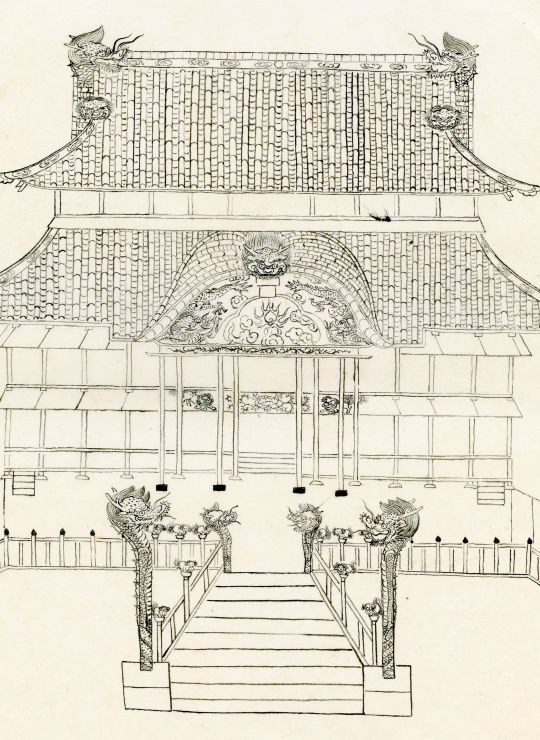
Shuri Castle - Burning castle of the Ryukyu Dynasty (Ref)
Shuri Castle, the royal castle of the Ryukyu Dynasty, was once the political, economic and cultural centre of that maritime kingdom. The date of construction of Shuri Castle is not known, but it is thought to have been built in the late 13th and 14th centuries during the Gusuku period.
Until the end of the 16th century, the Ryukyu Kingdom remained independent in turbulent East Asia, as did Korea and Vietnam, but was invaded and ruled by the Satsuma clan (now Kyusyu, Japan), and became a vassal state in the early 17th century.
After several fires and war damage, and repeated rebuilding, the World Heritage Site Shuri Castle was once again destroyed by a sudden fire on 31 October 2019, which lasted about eight hours and destroyed nine buildings and historical heritage sites, including the main hall. It is currently being rebuilt with a view to restoration in 2026.
The first burning occurred in 1453 during the struggle for the throne that followed the death of King Shō Kinpuku of the 1st Shō dynasty (Shiro-Furi Rebellion), when the castle was completely destroyed. The second fire, in 1660, took 11 years to rebuild, and the third fire in 1709 destroyed the main, north and south halls.
After the Ryukyu Disposition following the establishment of Okinawa Pref. by Japanese Government in 1879, the main hall and other buildings of Shuri Castle lost their role as the seat of government and were sold to the Japanese Army's 6th Division (Kumamoto, Japan) as a military camp and then to Shuri Ward (later Shuri City), which used them as school buildings for girls' schools.
It was almost completely destroyed during the Battle of Okinawa (WWⅡ) in 1945 and the construction of the University after the war, leaving only a small portion of the castle walls and building foundations remaining.
Full-scale reconstruction was considered in the 1980s, and the restoration work, which took about 40 years, was completed in January 2019. In October of the same year, a mysterious fire destroyed the castle again.
Shuri Castle, which has been repeatedly persecuted and burnt down but continues to revive, seems to symbolise Ryukyuan culture itself.
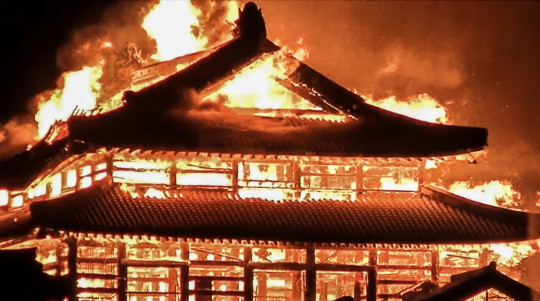
首里城 〜 燃え続ける琉球王朝のお城(参照)
琉球王朝の王城、首里城はかつてその海洋王国の政治・経済・文化の中心にあった。首里城の築城年代は明らかではないが、13世紀後半から14世紀にかけてのグスク造営期の時代に築城されたと考えられている。
琉球王国は16世紀末まで、朝鮮やベトナムと同様に激動の東アジアで独立を保っていたが、薩摩藩 (現在の九州)の侵略と支配を受け、17世紀初頭に属国となった。
世界遺産でもある首里城は、数度の火災や戦災を経て、再建を繰り返してきたが、ついに2019年10月31日、約8時間にわたる突然の火災により、本殿を含む9つの建物や歴史遺産を焼失した。現在、2026年の復興に向け、再建中である。
1度目の焼失は1453年に第一尚氏の尚金福王の死後に発生した王位争い (志魯・布里の乱) であり、城内は完全に破壊された。2度目の焼失は1660年のことであり再建に11年の年月を要した。1709年には3度目の火災が起き正殿・北殿・南殿などが焼失した。
1879年の日本政府による沖縄県設置に至る琉球処分以後は、正殿など首里城の建物は政府の所在地としての役割を喪失し、日本陸軍の第6師団 (熊本) の軍営として、その後は首里区 (後の首里市) に払い下げられ、女学校の校舎として利用された。
1945年の沖縄戦や戦後の琉球大学建設でほぼ全壊し、城壁や建物の基礎の一部が残るのみであった。1980年代に本格的な再建が検討され、約40年の歳月をかけた修復工事が2019年1月に完了した。同年10月、謎の大火災により再び焼失した。
迫害や焼失を繰り返しながらも復活を続ける首里城は、琉球文化そのものを象徴しているようだ。
103 notes
·
View notes
Text


The researchers believe that while a few individual Indochinese leopards (Panthera pardus delacouri) may still linger in Cambodia’s forests, the country no longer has a viable population of the subspecies.
“Given the current population status and myriad of threats, it is pretty certain that the Indochinese leopard now is functionally extinct in Cambodia,” study author Susana Rostro-Garcia, a scientist with the University of Oxford’s Wildlife Conservation Research Unit (WildCRU) and the NGO Panthera, told Mongabay [...]. Researchers conducted seven camera-trap surveys in Cambodia’s Eastern Plains between 2009 and 2019, revealing that the leopard population declined by 82% during that time. A further survey in 2021 found no leopards. (Individual leopards were caught on camera in Cambodia’s eastern highlands in 2022.)
The Indochinese leopard is critically endangered and its range has shrunk massively to as little as 2-6% of its former size. Cambodia’s population was considered a priority for conservation as one of the last viable, breeding populations, leaving remaining strongholds in Peninsular Malaysia, Thailand and Myanmar. [...]
“This is a big deal, because now both tigers and leopards are extirpated from Cambodia, Laos and Vietnam [...],” said Jan Kamler, a co-author on the paper [...]. “Alarmingly, there are no current conservation measures specifically focused on this Critically Endangered subspecies,” Rostro-Garcia said. “This unique subspecies is on the brink of extinction [...].”
---
Headline, image, caption, and all text above by: Sean Mowbray. “Study: Snares claim another local extinction as Cambodia loses its leopards.” Mongabay. 30 May 2023.
From elsewhere:
Distribution map of the leopard (Panthera pardus) showing widespread extinction in the past century:

The “Indochinese leopard” subspecies is noted here by its Latin name P.p. delacouri.
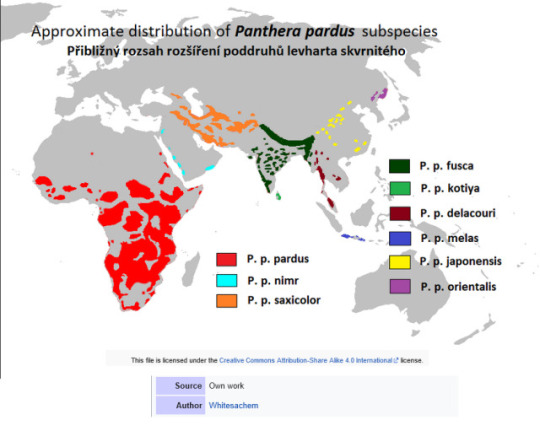
111 notes
·
View notes